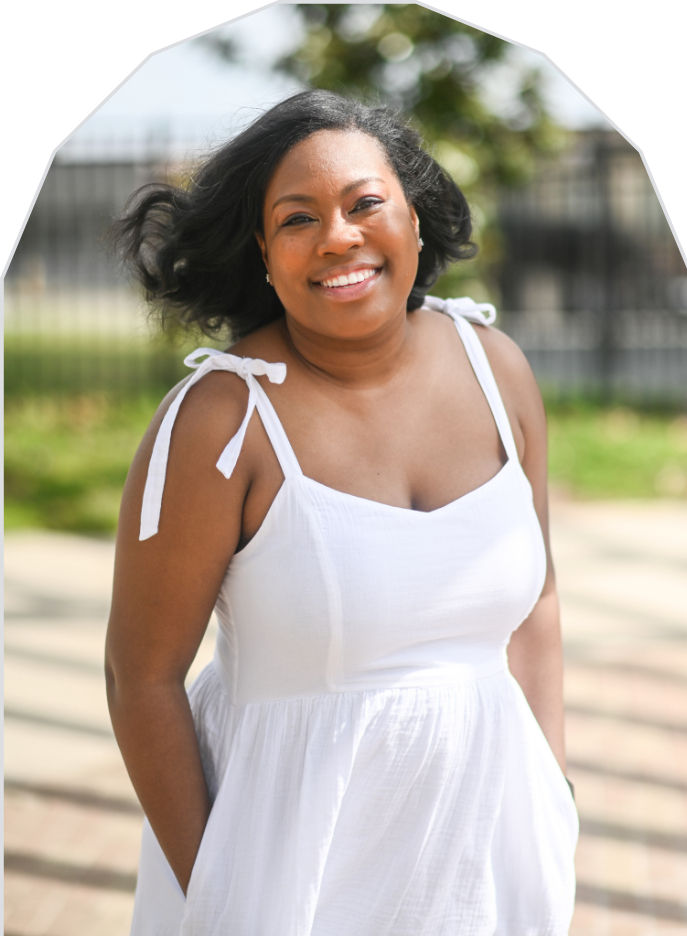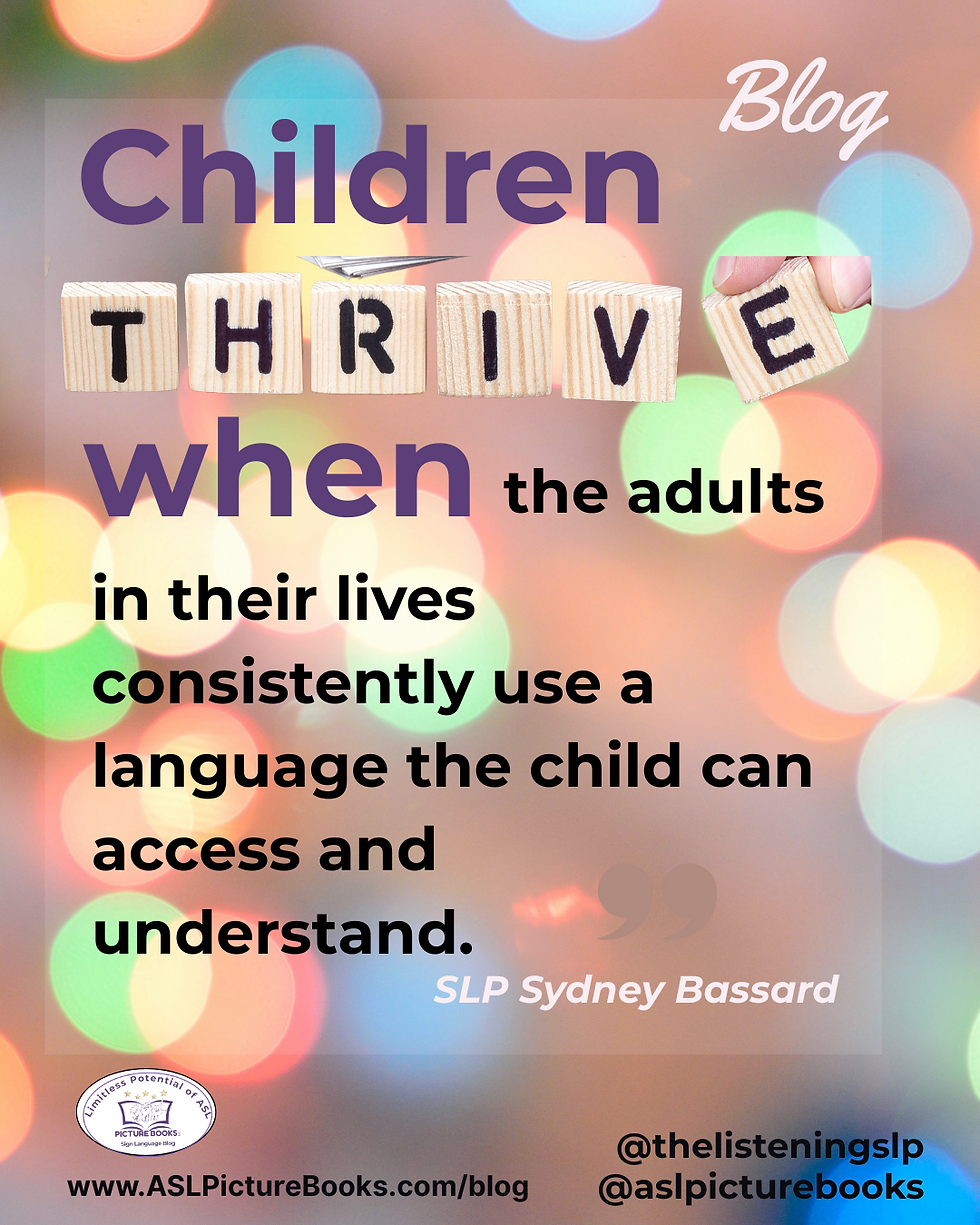Supporting Speech, Language, and the Family when Working with DHH Children
- Kathleen Marcath

- Jul 31
- 4 min read
3 Practical Tips from Sydney Bassard, SLP – The Listening SLP

Sydney Bassard, MSP, CCC-SLP, is a certified speech-language pathologist who specializes in supporting individuals who are d/Deaf and Hard-of-Hearing, with a strong focus on literacy development. She is the founder of The Listening SLP, a private practice and social media platform dedicated to empowering families, educators, and professionals with inclusive, evidence-based communication strategies.
Sydney has been nationally recognized by the American Speech-Language-Hearing Association (ASHA), earning distinction as a 2020 Early Career Professional and a 2023 Innovator for her work promoting health equity and accessible information for all.
At ASL Picture Books, we believe in uplifting professionals who help families build meaningful connections through language, especially when supporting d/Deaf and Hard-of-Hearing (DHH) children. We’re honored to welcome guest author Sydney Bassard, MSP, CCC-SLP, a nationally recognized speech-language pathologist and founder of The Listening SLP. In this article, Sydney shares three practical, compassionate tips that empower families to support language development at home, whether through spoken language, sign language, or both.
The Heart of the Work: Meeting Families Where They Are
When supporting Deaf and Hard-of-Hearing (DHH) children, one of the most powerful things we can do as professionals is to meet families where they are, especially when discussing language modalities. Families should be offered the full picture that includes spoken language, signed language, or a combination of both. Whether a family communicates using spoken language, American Sign Language (ASL), a combination of both, or uses a home sign system, honoring that modality is essential. Language access is the foundation of communication. Children thrive when the adults in their lives consistently use a language the child can access and understand.
The goal isn’t to push one approach—it’s to build connection through accessible communication. When we support families in their chosen modality, we’re not just supporting speech or sign—we’re supporting identity, relationships, and lifelong learning.

Focus on Language Before Speech Production
While speech development may be a goal for some families, accessible language must come first. Children need a strong foundation in understanding and expressing themselves—whether through words, signs, or a combination.
When we prioritize language access in the family’s chosen modality, we empower children to connect, to learn, and to thrive. Communication is not about perfection; it’s about connection.
Here are three tips I encourage families to use when working with their child to develop language:
1. Model Language During Daily Routines
Whether a family uses spoken language or sign language, routines like mealtime, bath time, or getting dressed are perfect opportunities for rich, meaningful language exposure. These repeated, predictable moments help DHH children connect language with actions and build understanding naturally.
Spoken: “Let’s wash your hands. First the soap, now rinse!”
Signed: Use consistent signs for routine words like eat, more, finished, or bath to build vocabulary.
2. Use Visual Supports
Visual aids—such as gestures, signs, pictures, and real objects—enhance understanding and reduce communication breakdowns, especially in early development or when hearing access is limited. DHH children benefit from multimodal input. Visual supports ensure that language is accessible, no matter the child’s listening ability at the moment.
Create visual schedules or picture cards
Point to objects as you label them
Pair spoken words with signs or gestures
3. Follow the Child’s Lead
Observe what the child is interested in and respond with language. If they’re playing with blocks, you might say or sign, “Block up! Uh-oh, it fell!” This technique builds engagement and motivation to communicate. Children learn best when they’re engaged. Following their interests helps language feel natural and fun, not forced.
Supporting the DHH Children Means Supporting the Family
Supporting DHH children means supporting the families who love them. When we honor the language modality of the home, whether it is spoken, signed, or both, we foster more than just language skills. We’re building confidence, community, and a path forward rooted in respect and belonging.
We’re so grateful to Sydney Bassard for sharing her insight and practical tips with the ASL Picture Books community. Her work reminds us that supporting Deaf and Hard-of-Hearing children begins with honoring each child’s unique language needs—and supporting families with empathy and expertise.
To learn more from Sydney, visit TheListeningSLP.com or connect with her across platforms for empowering resources, educational content, and real-life strategies to build communication and confidence every day.
📱 Social Media:
Instagram: @thelisteningslp
Facebook: @thelisteningslp
LinkedIn: The Listening SLP, PLLC
YouTube: Sydney Bassard | The Listening SLP
Keep the Journey Going
We hope you found Sydney’s three practical tips helpful and inspiring:
1️⃣ Model Language During Daily Routines
2️⃣ Use Visual Supports
3️⃣ Follow the Child’s Lead
Whether you’re just getting started or have been signing for a while, your efforts are opening a beautiful world of communication for the children in your life—and that’s something to celebrate. 💛
Before you go, here are a few ways to keep growing on your ASL journey:
📚 Read Next: Explore more inspiring posts on our blog to continue learning and celebrating Deaf culture. Visit the blog »
🎤 Author Visits: Bring the magic of ASL to your school or library! Book an author visit to inspire your students and community. Learn more »
🖐️ Freebie – ASL Starter Kit: Grab your free printable ASL Alphabet Chart and starter resources—perfect for the fridge, classroom wall, or playroom. Get the free ASL Starter Kit. »
💌 Join Our Community: Sign up for our newsletter to receive tips, free resources, and uplifting stories delivered right to your inbox. Subscribe here »
🎨 Pre-Order Now: Reserve your copy of My Monster Truck Goes Everywhere with Me: Coloring & Activity Book—packed with fun ASL learning, puzzles, and creative play. Pre-order today »
Meet the Author: Kathleen Marcath

Kathleen Marcath is the award-winning author of My Monster Truck Goes Everywhere with Me and the founder of ASL Picture Books. She’s on a mission to share the joy of bilingual (ASL and English) education, creating stories that help children and families discover the limitless potential of ASL.
Stay in Touch: Follow Kathleen on Facebook and Instagram, or visit ASLPictureBooks.com for more resources and community updates.
.jpg)



Comments